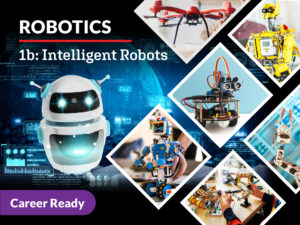STEM Resources
Science, technology, engineering, and math (STEM) is crucial because it equips students with essential skills for the modern world, including:
- Encouraging critical thinking & problem-solving
- Preparing students for high-demand, high-paying career fields
- Fostering innovation & creativity
If students explore STEM early on, they increase their employability skills and have an increased chance of discovering high-demand career areas that align with their interests and skills to support the soaring economic need.
eDynamic Learning offers several resources (grades 5-12) to support STEM-focused courses, STEM CTE pathways, as well as integrating STEM into core courses. Our suite of comprehensive Digital Curriculum courses as well as supplemental materials through Learning Blade missions enable us to help fit the needs of your students.
Helpful Resources
[Webinar] STEM Education: Building the Workforce of Tomorrow
[Customer Story] Supporting Teachers with a Toolbox of STEM Resources
[Use Cases] 30 Practical Ideas to Increase STEM and Career Awareness In Your Classroom
STEM in the Middle Grades (5-9)
The benefits of early STEM education can be far-reaching. With Learning Blade you can easily integrate STEM, CS, and CTE concepts into a child’s education. Appropriate for grades 5-9, Learning Blade provides supplemental materials to contextualize science, math, English and social studies lessons by grounding them in careers and technologies. Each of our lessons and resources is indexed so you can see what state standards are being met.
Regardless of a teacher’s personal experience with STEM, coding, and AI our resources can be implemented into the classroom.
With over 100 careers and technologies in our 13 missions and 4 modules, you can easily find the right content for your classroom.
Middle School Comprehensive STEM Curriculum
Our comprehensive Digital Curriculum gives teachers a rich set of resources that teach these skills, while cover topics such as:
- What is STEM
- Launching a STEM Project
- STEM and Society
- STEM Systems
- STEM Electronics
- Computing with STEM
High School STEM Electives and CTE Pathways
With our robust library of comprehensive Digital Curriculum you can provide students with options to meet their interests and offer courses aligned to your community needs. Each course provides a full semesters curriculum making it a complete textbook replacement.
Our award-winning instructional framework offers one consistent and simplistic design and interface that employs backwards design methodology to support best practices on how today’s students learn. All of our courses are developed in-house by teachers and subject matter experts and each course is designed and written with engaging curriculum narratives. Within our Digital Curriculum courses each lesson is chunked into bite-sized pieces of text with the integration of visuals to keep students engaged. Teachers can also customize course units and lessons allowing you to personalize your instruction.
In addition, many of the Career Ready courses prepare students for industry certifications, which are valued by industries and can often take the place of or prepare students for additional educational training.






















